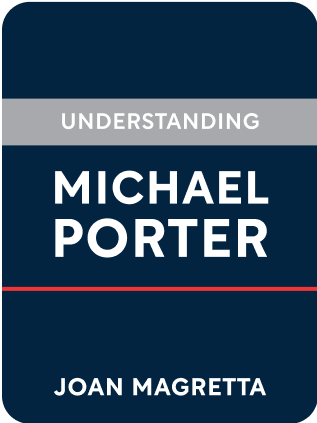

This article is an excerpt from the Shortform summary of "Understanding Michael Porter" by Joan Magretta. Shortform has the world's best summaries of books you should be reading.
Like this article? Sign up for a free trial here .
What makes a good strategy in business, and why? How do you know if your strategy is good or bad?
Here are five key tests for defining a good strategy, as defined by famed business professor Michael Porter. We’ll also discuss what bad strategies tend to be, and how to avoid them/
What Make a Good Business Strategy?
If you have a real competitive advantage, compared with rivals, you operate at a lower cost, command a premium price, or both. A good strategy is a set of activities that achieves competitive advantage.
Strategy is not simply the value proposition itself – strategy must describe how the value is being created and delivered.
A good strategy should pass five tests:
- Is there a distinctive value proposition?
- Is there a unique set of activities?
- Are the trade-offs different from rivals?
- Do the activities fit with each other?
- Is there continuity over time?
A good strategy delivers distinctive value through a distinctive value chain. It must perform different activities from rivals, or perform similar activities in different ways.
If the activities reinforce each other, imitating them all is difficult. If they involve trade-offs, your activities may contradict those of competitors, making it difficult for them to plunge in.
In one sense, strategy is choosing what not to do.
Bad Strategies
Strategy is the means by which a company, faced with competition, achieves superior profitability. Profits = Prices – Costs
As explained in the rest of the book, a superior strategy is a combination of unique activities that is hard to replicate, allowing you to increase prices for superior value and/or decrease costs uniquely.
Here are examples of bad strategies that won’t lead to a viable long-term advantage.
Operational Effectiveness
Competing using the same activities as competitors, but hoping to do it better, is often called operational effectiveness. This is an unsustainable strategy. Your best practices will quickly be copied by others, with the help of eager consultants, leading to competitive convergence.
This leads to a competition based solely on price, where products are undifferentiated and competitors erode each other’s profits.
Competition here is zero-sum. While in the short-term this improves consumer surplus, in the long term competitors merge or die, thus decreasing consumer choice, leaving customers under-served or over-served.
Poor profitability undermines investment, making it harder to improve value for customers or fend off rivals.
Economies of Scale
There are advantages to being bigger in most businesses. This insidiously promotes “winner-takes-all” thinking. Mergers and acquisitions also fall into this bucket.
Unfortunately, economies of scale are exhausted at a relatively small share of sales. There’s little evidence showing that companies with the largest market share are the most profitable. It’s critical to examine the numbers and examine the mechanism by which size leads to better profits.
Seek to be “big enough” – say 10% of the market – rather than to dominate it.
Serving All Market Needs
By trying to be something for everyone, you risk being everything to no one. In contrast, competitors who focus on a specific need will attract that segment of customers.
A common pitfall is that companies expect their customers to stay loyal to their brand when the company releases new products. “If customers come to us for auto loans, surely they would also come to us for home mortgages.” This loyalty is often overestimated. Consumers are fine going to different vendors for different products, if the value is superior.
In the extreme, consumer packaged goods companies like Johnson & Johnson have totally different brands for different categories – you don’t see Tide toilet cleaners.
For example, it’d be a mistake for In-N-Out to start a fancier sit-down restaurant brand like In-N-Out Gourmet, for a few reasons:
- Their current activities are ill-suited for servicing the new segment. Starting a sit-down restaurant and operating a fast food restaurant require very different activities, some of them contradictory.
- This expansion would pollute the brand and what In-N-Out stands for in customers’ minds.
- Customers are happy going to other restaurants for fancier burgers. They don’t need In-N-Out specifically to fill that need, nor will their loyalty to In-N-Out carry over strongly to their new product.
Miscellaneous Bad Strategies
The following are not strategies, because they describe goals or tools, not how you will accomplish the goal:
- Our strategy is to be the best. (Jack Welch at GE was famous for this.)
- Our strategy is people.
- Our strategy is to increase shareholder value.
- Our strategy is to execute better than competitors.
- Our strategy is [our value proposition].
Fit Between Activities
Good strategies depend on the connection among many things. Fit means the value or cost of one activity is affected by the way other activities are performed – in other words, “synergy.” If the activities fit together, they each meaningfully contribute to the company’s increased value or lower cost, and they work strongly together.
This is a clear departure from the (mistaken) idea of the one core competence. If strategy truly is based on one core competence, then it becomes relatively easy to replicate. More often, industries compete fiercely to control the one key “resource” – distribution channels, product portfolios – thus driving up cost. In reality, strong strategies are built on many unique activities that fit together to deliver the unique value proposition.
Fit arises in 3 ways:
- Basic consistency: each activity aligns with the company’s value proposition and contributes incrementally.
- Example: many of Southwest’s activities are directionally pointed toward lowering cost and increasing convenience.
- When activities are inconsistent, they cancel each other out.
- Activities complement or reinforce each other: real synergy.
- Netflix’s large catalogue gives more chances to collect data points to make better recommendations.
- Substitution: Performing one activity makes it possible to eliminate another – within the company, or for customers/suppliers in the value system.
- IKEA’s room displays substitute for sales associates, thus lowering cost.
- Dell will preload software onto PCs, substituting for the customer’s IT department.
Fit discourages rivals in a few ways:
- With a large range of activities, it becomes unclear which of the company’s activities are most valuable to replicate.
- For a rival to achieve the same competitive advantage, they would need to replicate all the activities, which becomes exponentially harder with each activity.
- As a simplistic example, say there are 5 activities that give a company a competitive advantage. If the chance of replicating one activity is 90%, then the chance of replicating all of them is 0.9^5, or 62%.
- An activity that fits one value chain can punish a different value chain, if it lacks synergies with the other activities or contradicts them.
- Activities with fit make it easier to see where the weak link in the chain is.
So what is a good strategy? Now that you know about bad strategies, you’ll have a better sense about good strategies and how to achieve them.

———End of Preview———
Like what you just read? Read the rest of the world's best summary of Joan Magretta's "Understanding Michael Porter" at Shortform .
Here's what you'll find in our full Understanding Michael Porter summary :
- How Porter's famous Five Forces help you analyze every industry
- How IKEA, Southwest Airlines, and Zara have ironclad, defensible strategies
- Why the best companies reject opportunities to focus on what they know






